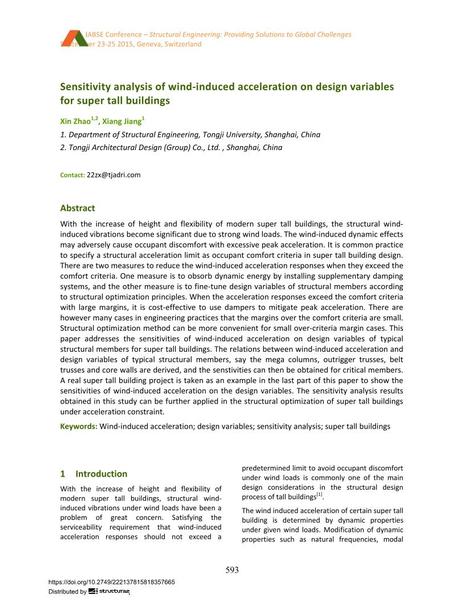Sensitivity analysis of wind-induced acceleration on design variables for super tall buildings

|
|
|||||||||||
Bibliographic Details
| Author(s): |
Xin Zhao
(Department of Structural Engineering, Tongji University, Shanghai, China; Tongji Architectural Design (Group) Co., Ltd. , Shanghai, China)
Xiang Jiang (Department of Structural Engineering, Tongji University, Shanghai, China) |
||||
|---|---|---|---|---|---|
| Medium: | conference paper | ||||
| Language(s): | English | ||||
| Conference: | IABSE Conference: Structural Engineering: Providing Solutions to Global Challenges, Geneva, Switzerland, September 2015 | ||||
| Published in: | IABSE Conference Geneva 2015 | ||||
|
|||||
| Page(s): | 593-599 | ||||
| Total no. of pages: | 7 | ||||
| Year: | 2015 | ||||
| DOI: | 10.2749/222137815818357665 | ||||
| Abstract: |
With the increase of height and flexibility of modern super tall buildings, the structural wind- induced vibrations become significant due to strong wind loads. The wind-induced dynamic effects may adversely cause occupant discomfort with excessive peak acceleration. It is common practice to specify a structural acceleration limit as occupant comfort criteria in super tall building design. There are two measures to reduce the wind-induced acceleration responses when they exceed the comfort criteria. One measure is to obsorb dynamic energy by installing supplementary damping systems, and the other measure is to fine-tune design variables of structural members according to structural optimization principles. When the acceleration responses exceed the comfort criteria with large margins, it is cost-effective to use dampers to mitigate peak acceleration. There are however many cases in engineering practices that the margins over the comfort criteria are small. Structural optimization method can be more convenient for small over-criteria margin cases. This paper addresses the sensitivities of wind-induced acceleration on design variables of typical structural members for super tall buildings. The relations between wind-induced acceleration and design variables of typical structural members, say the mega columns, outrigger trusses, belt trusses and core walls are derived, and the senstivities can then be obtained for critical members. A real super tall building project is taken as an example in the last part of this paper to show the sensitivities of wind-induced acceleration on the design variables. The sensitivity analysis results obtained in this study can be further applied in the structural optimization of super tall buildings under acceleration constraint. |
||||
| Keywords: |
sensitivity analysis super tall buildings Wind-induced acceleration design variables
|
||||
